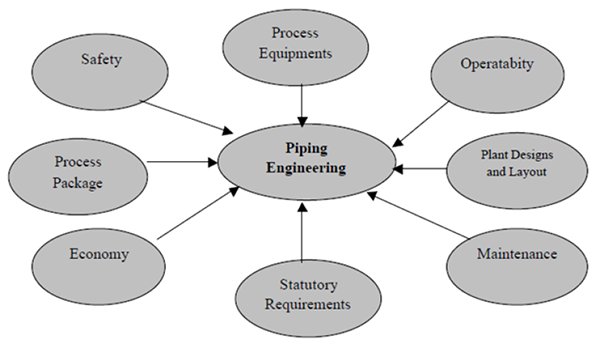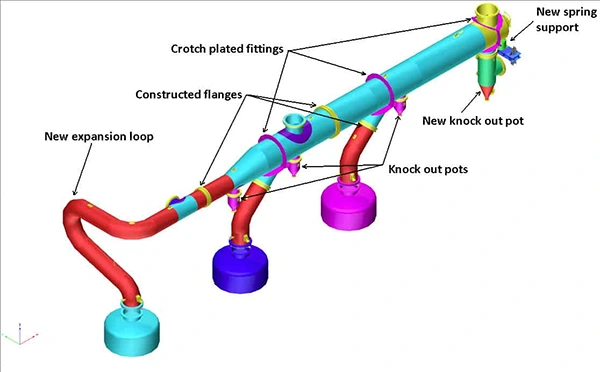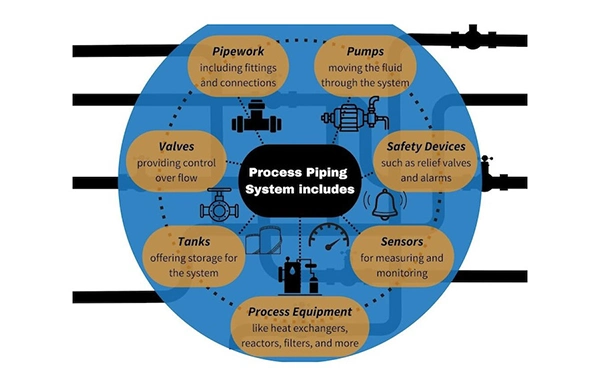The Superior Guide to Piping Design: The Basics, Implementation, and How Tech Can Help
Piping designs are the backbone of many diverse industries, be it from oil and gas refineries to even a pharmaceutical company. Not only does this ensure a smooth flow of fluids and gases but also reduces the overall energy cost. (Source: CromaCampus)
So, in this read, I’ll be taking on a journey to the fundamentals of piping designs, their implementations, and how they actually work in an industry.
Let’s start!
What is Piping?

Piping is a network of pipes through which fluids, liquids and or gases are transferred from one location to another location. These systems are ubiquitous and found in various settings, including:
Residential Buildings:
In residential building structures, piping serves both the supply and disposal of water, the removal of sewage, and the transportation of natural gas. These systems remain critically important in the delivery of water, efficient drainage, and supply of power to the homes.
Commercial Buildings:
The building’s piping system is more elaborate and mainstream for commercial buildings because buildings require many fluids (chilled water, steam, hot water, etc.) to function. These systems provide the mechanical, electrical, and plumbing MEP primary support infrastructure for the building.
Industrial Facilities:
Piping systems are used extensively in industries particularly manufacturing and processing plants, where materials, chemicals, and finished products move through the system. It is important to notice that these systems serve as important components in maintaining system and organizational functionality and efficiency.
Infrastructure:
Large construction projects, including water treatment facilities, electrical stations, oil and gas conduits, are dependent on pipeline solutions as a core element. Such systems move fluids over great distances and are instrumental in the distribution of valuable goods.
Understanding Pipe Design

Piping design can best be described as a sub-discipline of engineering in which the main concern is the most efficient and safest way of moving fluids within a plant. It involves a complex interplay of various factors, including:
Fluid Properties:
The properties of the fluid that tends to flow in the pipes, such as the viscosity, density, and temperature, affect the size, type, and model of the pipes, fittings, and valves to be used.
Operating Conditions:
Design considerations that should be taken into account include the following: During the pipe sizing, a number of factors that pertain to the working conditions of the piping system come into play.
Material Selection:
Pipes, fittings, valves, and various related products are prepared from raw materials like carbon steel, stainless steel, copper as well as plastic. The selection of the material is influenced by the cost, durability, and compatibility of the material with the fluid.
Pipe Sizing:
The diameter of the pipes and fluently used fittings also play a very important role in whether the system will be able to cater to the necessary fluid flow rates and pressure.
Code Compliance:
Piping systems are subject to numerous requirements of industry standards and other regulations to assure safety, quality, and reliability.
Fundamental Aspects of a Piping System

A common piping system is made of several elements and components arranged to enable proper and effective conveyance of fluid. These components include:
Pipes:
Pipes are a part of the piping system that transmits fluids; they are the most crucial of the two. Pipes can be made with a variety of substances, all of which can vary in diameter and will be offered in many forms.
Fittings:
Fittings join piping and are used to turn pipes, change diameter or direction, or vary the pipe’s height. Fittings standards are tees, elbows, reducers, and unions.
Valves:
As for process control, valves regulate the amount of fluids that pass through them either by allowing full flow, partially, or stopping it altogether. The importance of valves cannot be underestimated because they are used to manage and direct the flow of fluids in the pipe system.
Flanges:
A flange is a projecting ring that is used to join pipes, valves, or other equipment together. They can easily be disassembled and maintained compared to other conventional piping systems.
Gaskets:
Gaskets fit between flanges to prevent loss of fluids in a system within pipes and hoses.
Supports and Hangers:
Supports and hangers: They keep the pipes in position, distribute the load and minimize the cantilever load. These components are important requirements essential for the reinforcement of the piping system.
Instruments and Controls:
They provide control of the piping system. Some of them are flow meters, pressure gauges, temperature sensors, and control valves.
Do You Know?
According to the Plant and Piping Design, the piping design criteria include several factors like temperature, pressure, corrosion, and mechanical stress.
The Piping Design Process
Designing a piping system is a multi-faceted process that involves several crucial steps:
- Conceptual Design: First deals with determining what, precisely, a project is, how extensive it is, and what one hopes to achieve at the end of the process.
- Process and Instrumentation Diagrams (P&IDs): P&IDs are, in fact, drawings of the piping system showing process equipment, measurement devices, and control systems.
- Piping and Instrumentation Diagrams (P&IDs): P&IDs depict the general arrangement of the piping system together with the pipe sizes, fittings, valves, and instruments.
- Stress Analysis: This step consists of assessing stress concentration and checking that the piping system should be able to support operational loads and forces.
- Material Selection: Engineering personnel have to choose the right material for pipes, fittings, and valves depending on the fluids being handled, operating conditions, and the external environment.
- Support Design: To support a load in pipes, supports and hangers must be able to suspend them and distribute loads in such a way that loads will not concentrate.
- Detailed Drawings: Designers draw sketches of the pipe system which include dimensions, parts of the pipe, and other information about installation.
- Procurement and Construction: When the piping system design is complete, the piping system parts need to be purchased and placed in the field.
- Testing and Commissioning: Fabrication of the completed piping system involves a thorough assessment to confirm that the system has been fabricated and conforms to the design requirements and functionality.
Piping Design Considerations
Several critical considerations must be taken into account during the piping design process to ensure a safe, efficient, and reliable system:
Safety:
Piping systems have to be designed in such a way that they would not pose leakage or explosion risks that put the lives of people and property in danger.
Efficiency:
The design should, therefore, ensure optimal energy use, minimize the times that the system will be off, and at the same time, increase the rates of work.
Maintainability:
It should be convenient to work on the components for repairing and even replacing as required.
Cost-effectiveness:
Another critical challenge that engineers face is the choice of the precise cost of installing and implementing an LV system as compared to a longer-term expenditure of operating and maintaining the LV system.
Environmental impact:
These should show how the implementation design is environmentally friendly in terms of waste, emissions, and energy usage.
Trends: To Be Expected in the Near Piping Design
Since piping design has become a sophisticated profession over the course of several decades, it is affected by the growth of science and technologies from time to time. Some key future trends in piping design engineering services include:
Modularization and Prefabrication:
Pre-fabrication of piping components and systems is efficient and economical and decreases the chances of risk on site.
Advanced Materials:
Advancements in technology in the materials science field can mean that piping components are made out of a material that is lighter, stronger and more resistant to degradation than previously.
Smart Piping Systems:
Piping systems may become more durable, perform better, and be safer through the incorporation of sensors, actuators, and control systems.
Sustainability:
What will be more apparent in piping design is the need to incorporate energy-saving materials, reduced waste, and recyclable materials into the design.
Digitalization:
Modern technologies such as simulation software, digital twins of the system, and big data management help to enhance the design process, understand the requirements for future system working conditions, and carry out the predictive maintenance process.
Conclusion
The dynamics of piping design are dynamic and that is why one needs to be acquainted with the details of the profession’s most recent developments, standards, and trends. Together with the knowledge of piping design principles, practices, and applications, the engineering and technical specialists will be able to design and develop effective and safe systems that are necessary for modern infrastructure projects.
